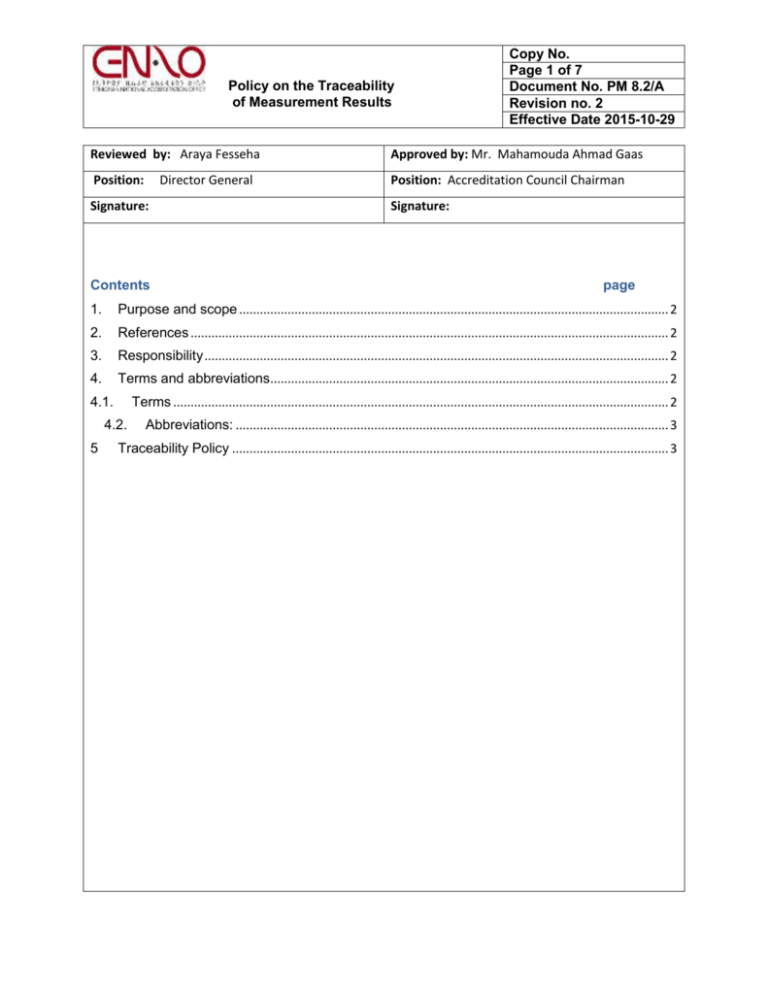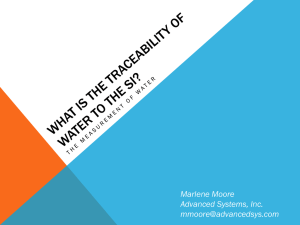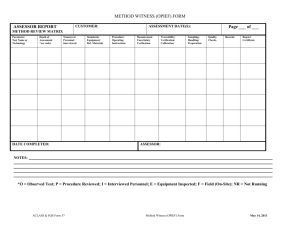PM 08.2A Policy on the Traceability of Measurement Results
advertisement

Policy on the Traceability of Measurement Results Copy No. Page 1 of 7 Document No. PM 8.2/A Revision no. 2 Effective Date 2015-10-29 Reviewed by: Araya Fesseha Approved by: Mr. Mahamouda Ahmad Gaas Position: Position: Accreditation Council Chairman Director General Signature: Contents Signature: page 1. Purpose and scope ............................................................................................................................ 2 2. References .......................................................................................................................................... 2 3. Responsibility ...................................................................................................................................... 2 4. Terms and abbreviations................................................................................................................... 2 Terms ............................................................................................................................................... 2 4.1. 4.2. 5 Abbreviations: ............................................................................................................................. 3 Traceability Policy .............................................................................................................................. 3 Policy on the Traceability of Measurement Results Copy No. Page 2 of 7 Document No. PM 8.2/A Revision no. 2 Effective Date 2015-10-29 1. Purpose and scope This policy document details the traceability requirements of ENAO and acceptable traceability terms for CABs. This document is applicable for all conformity assessment bodies (CABs) accredited under ENAO accreditation Program. 2. References ILAC P10:2013:- ILAC Policy on the Traceability of Measurement, International vocabulary of metrology – Basic and general concepts and associated terms (VIM) ILAC P14:2013 ILAC policy for uncertainty in calibration 3. Responsibility It is the responsibility of Accreditation Director and Respective Team for the implementation of this policy. 4. Terms and abbreviations 4.1. Terms Metrological traceability: - is the property of a measurement result whereby the result can be related to a reference through a documented unbroken chain of calibrations, each contributing to the measurement uncertainty (VIM: 2010). Reference Standard: - The standard used to calibrate the working standard (e.g., reference thermometers, masses). These shall be calibrated externally. Working Standard: - Routinely used to verify measuring instruments or measuring systems (e.g., working thermometers). Reference Material (RM):- Material or substance one or more of whose property values are sufficiently homogeneous and well established to be used for the calibration of an apparatus, the assessment of a measurement method, or for assigning values to the materials. (ISO/IEC Guide 43-1) Certified Reference Material (CRM):- A Reference Material accompanied by documentation issued by an authoritative body and providing one or more specified property values with associated uncertainties and trace abilities using valid procedures. Policy on the Traceability of Measurement Results Copy No. Page 3 of 7 Document No. PM 8.2/A Revision no. 2 Effective Date 2015-10-29 Critical equipments:-equipments used for direct measurement of measurand reported or measurand to be directly/indirectly used in calculation of result to be included in a report / certificate. Appropriate NMIs/Calibration laboratories:-those NMIs defined in option 1 or Calibration labs as in option 2 otherwise proven to be competent sources of traceability for cases of options 3A/3B. 4.2. Abbreviations: BIPM: international committee for weight and measures BMC: best measuring capability CABs: conformity assessment bodies CIPM: international committee for weight and measures CMC: calibration measuring capability ILC: Inter laboratory comparison KCDB: key comparison data base MRA: mutual recognition arrangement NMI: National metrology Institute RMPs: reference material producers 5 Traceability Policy 5.1. ENAO accredited/ Applicant Conformity assessment bodies (CABs) are required to have an established calibration program of critical equipments, reference standards, and hence the measurement results generated by that equipment, relevant to their scopes of accreditation, are traceable to the International System of Units (SI units) through appropriate a National Metrology Institute (NMI) ,other Metrology bodies or calibration laboratories via an unbroken chain of comparisons as detailed below.. Therefore all equipment used by ENAO accredited CABs including equipment for subsidiary measurements (e.g., for environmental conditions) having a significant effect on the accuracy or validity of the test/calibration result (e.g., Policy on the Traceability of Measurement Results Copy No. Page 4 of 7 Document No. PM 8.2/A Revision no. 2 Effective Date 2015-10-29 significant contributor to overall CABs services uncertainty, etc.) shall be calibrated before being put into use. Moreover when traceability to SI units is not possible or practical ENAO accredited/applicant CABs shall insure traceability of RMs To CRMs from acceptable sources, where applicable RMPs that have accredited/implemented ISO guide 34:2009. 5.2. Metrological traceability can be demonstrated by having calibrations performed by appropriate NMIs/Calibration laboratories. These calibration services specifically shall be obtained from the following four alternative sources of traceability. I) NMI whose service is suitable for the intended calibration and is covered by the CIPM MRA which can be viewed in Appendix C of the BIPM KCDB or II) An accredited calibration laboratory whose service is suitable for the intended need (i.e., the scope of accreditation specifically covers the appropriate calibration range) and the Accreditation Body is covered by the ILAC Arrangement or by Regional Arrangements recognized by ILAC. IIIa) NMI whose service is suitable for the intended need but not covered by the CIPM MRA with demonstrated competence as described or. IIIb) A calibration laboratory whose service is suitable for the intended need but not covered by the ILAC Arrangement or by Regional Arrangements recognized by ILAC with demonstrated competence as described. In cases where traceability is established through either IIIa) or IIIb) , ENAO insures that the following appropriate evidence of technical competence is verified and documented for non accredited calibration laboratories and NMI Non MRA signatory to CIPM and/or range and uncertainties not published on appendix C of BIPM KCDB . This evidence for the technical competence of the laboratory and claimed metrological traceability is likely to include but not limited to the following: Records of calibration method validation Procedures for estimation of uncertainty Documentation for traceability of measurements Policy on the Traceability of Measurement Results Copy No. Page 5 of 7 Document No. PM 8.2/A Revision no. 2 Effective Date 2015-10-29 Documentation for assuring the quality of calibration results Documentation for competence of staff Documentation for accommodation and environmental conditions Audits of the calibration laboratory The choice of route IIIa) or IIIb) is unlikely to be made on purely economic grounds, and is more likely to be a last resort if other routes are unavailable, as the first two alternatives are best alternatives in traceability. ENAO accredited calibration laboratory or NMI evaluated by ENAO or laboratory evaluated by ENAO for proving technical competence shall be considered as evidences for option IIIa and IIIb. when traceability to SI units is not possible or practical ENAO accredited/applicant CABs shall insure traceability of RMs by using certified reference materials from accredited Reference Material Producers (RMPs), where available, and practicable Accredited laboratories may perform internal calibrations for their own working instruments provided: The laboratory has documented procedures for this internal calibrations task; The laboratory reference instrument/standard from which traceability is derived, has been calibrated by an accredited calibration laboratory or NMI; and, Training records must be maintained for staff performing calibrations and these records must demonstrate the technical competence. ENAO also recognize traceability to specified methods and /or consensus standards that are clearly described and agreed by all parties concerned. The laboratory shall provide satisfactory evidence of correlation of results for example by participating in inter laboratory comparison (ILC), Proficiency Testing and/ or performance characteristics checks against manufacturer’s standards. 5.3. The laboratory calibration program shall specify frequency of re-calibration. The frequency of re-calibration is dependent on many factors (e.g., whether it is a reference standard, frequency of use, stability, etc…). Although the frequency of re-calibration may be extended, it Policy on the Traceability of Measurement Results Copy No. Page 6 of 7 Document No. PM 8.2/A Revision no. 2 Effective Date 2015-10-29 cannot be eliminated. 5.4. When using an external calibration service to comply with this policy, the calibration laboratory used must be accredited/proven competent using ISO/IEC 17025:2005 and provide an appropriate calibration certificate. When looking at the calibration certificate the following things should appear on the certificate: - An indication that the calibration laboratory is accredited to ISO/IEC 17025:2005 by a ILAC recognized and named accreditation body ; -The serial number of the measuring equipment (or reference standards) being used to calibrate CAB’s equipment and - A statement that the measuring equipment (or reference standard) is traceable to SI units 5.5. If newly purchased measurement equipment is provided with/without an appropriate calibration certificate, its calibration shall be performed prior to use. 5.6. Instruments that drift, or are prone to sudden changes in precision or measurement capability, requires periodic verification/intermediate check. The verifications/intermediate shall be appropriate to the range of the use of the instrument. Note:-Verification does not establish traceability. It is not a method of propagating uncertainties, which is the core issue in a calibration. Verification seeks only to determine whether or not the instrument is operating within its expected tolerances. Tolerances are not always the same as uncertainties. For these types of instruments that require verification/intermediate check, the laboratory must have verification/intermediate check procedures that detail: How to conduct verification /intermediate check, The frequency of verifications; The acceptance criteria; and, Actions taken when the acceptance criteria are not met (e.g., recall of data, etc.) Policy on the Traceability of Measurement Results Revision No 1 Copy No. Page 7 of 7 Document No. PM 8.2/A Revision no. 2 Effective Date 2015-10-29 Date approved Revision History 2015-05-20 The title of the document was changed to Policy on the Traceability of Measurement Results Clause 3 was revised to include responsibility for the implementation of this document. Clause 4.8 was revised to make more clear how ENAO handle the options to accept metrological traceability from accredited labs which are not covered by ILAC MRA or from NMIs which are not covered by CIPM MRA. Clause 4.8 was removed to make more clear how ENAO handle the options to accept metrological traceability from accredited labs which are not covered by ILAC MRA or from NMIs which are not covered by CIPM MRA with conditions of 2 2015-10-29 similar to annex A on ILAC P10. Clause 4.2 was revised to describe routes of metrological traceability specially how it can be verified for non accredited CAL labs and non MRA signatory NMIs Acronyms and definition of terminologies added to clarify and make document self explanatory.


